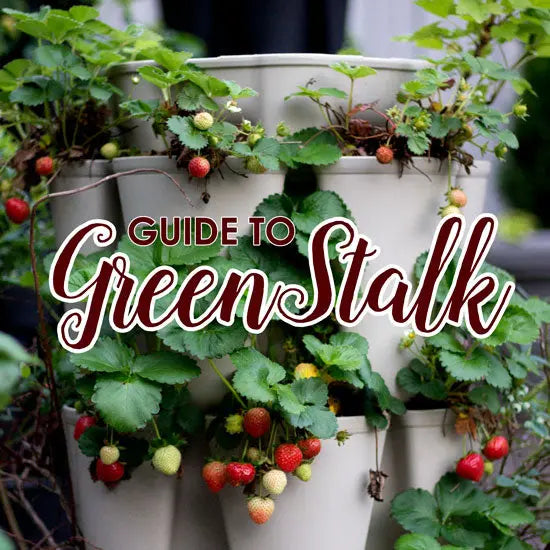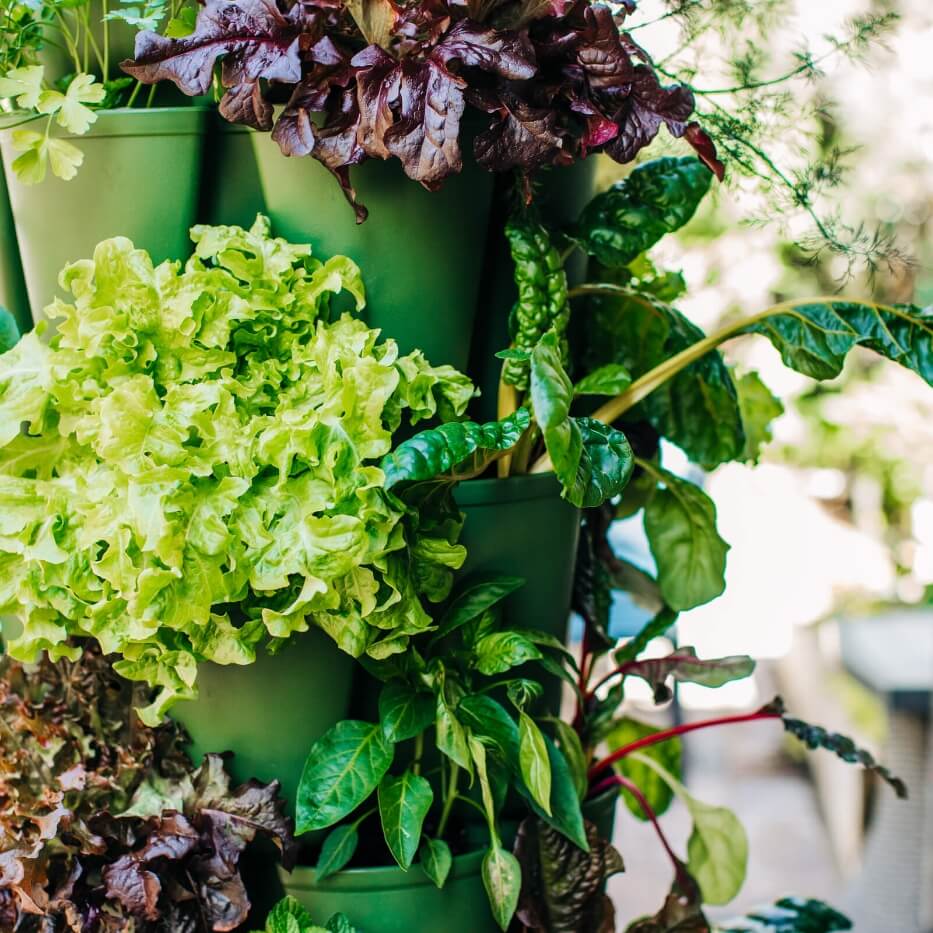In this post I will be answering commonly asked questions and concerns with growing vertically - specifically in the GreenStalk Vertical Planter. I will be sharing my personal experience as well as what we have learned as a company. These tips will help every gardener have success growing in the GreenStalk!

Making a Plan
This is essential. Don't wait until you are trying to set up your vertical garden to try to figure out where to put it and what to grow. Decide on the best location for your planter, what type of soil you will use and what you want to grow ahead of time. Generally, you want a location with full sun. Most vegetables, fruits and annuals will thrive in full sun. Check the plant label or seed packet label to make sure that your plant's sun requirements match the spot you have your planter in. If you are growing against a wall or beside a large object that will block the sun on one or more sides, it would be beneficial to add a Moveror Spinnerto your order to make sure all plants have the same access to light. Rotate once every day or two to keep sun loving plants from getting leggy. Make sure to leave at least 2 feet between other planters or objects around the GreenStalk (like railings) to ensure your plants have enough room to grow up and out. Next, determine what type of soil you want to use. We strongly recommend going with a potting mix or soil that has ingredients mixed specifically for containers. I've used Happy Frog and Pro-Mix with success in the past. Every area of the country has different brands of potting mixes so you may not be able to find the ones I've mentioned, and that's ok. If you can't find those mixes, ask your local garden center what they would recommend. Look for something lightweight with good water retention.
Finally, plan what you are going to plant. Sometimes this is the hardest step! There are SO many options of what you can grow in a GreenStalk Vertical Planter. You can mix and match root vegetables with large vegetables like tomatoes and smaller ones like lettuce. The rule of thumb to keep in mind is that you grow your larger plants on the bottom and smaller or same sized ones above that - so they don't shade each other out. Just do a quick search to find out how large your plants get and plant accordingly.
Along with that step, you'll need to know what to plant in what season. A GreenStalk Garden can get multiple plantings in a single year.
For spring and fall gardens, plant:
Lettuce, Kale, Collards, Cabbage, Carrots, Onions, Cilantro, Spinach, Broccoli, Califlower
For summer gardens, consider:
Tomatoes (compact varieties work best), eggplant, peppers, corn, cucumbers (bushy varieties work best), herbs

Planting it Up
This is the fun part! First, take all your needed materials to the location in your garden where you plan to keep the GreenStalk (unless you have the Mover, then you can plant anywhere and just move it where needed). Layout all the pieces and make sure you have everything you need. Next, fill the GreenStalk with your chosen potting mix. It you are growing from seed, fill the mix to the very top of the planter. If you are growing from starter plants, leave an inch or two from the top to make sure you have space to plant. Never pat the soil down. You are ready to plant! Simply add your seeds and starter plants to each "pocket" of the planter. Depending on the size of your plant, you may be able to grow up to 3 plants per pocket. For example, you can fit 3 carrots, spinach, or radishes per pocket since they stay so small and compact. But larger plants like eggplant and tomatoes will need some extra space, so just plant one per pocket of those.
Once you have it all planted, stack it up. Start with a single planter, then add a clean grey watering disk, then another planter, and another grey disk and so on till you reach the top. Take care in locking the planters together. The "feet" of the planters fit into the ones below. Once you place the top water reservoir on, it's time to water. Start by filling the reservoir to the appropriate mark (3 for the 3 tier, 4 for the 4 tier, and 5 for the 5 tier), then gently water in your seeds and starter plants by filling each pocket being careful not to displace any seeds. Since it's the first time watering, make sure the soil is fully saturated.

Maintenance
This is where things can go awry if you let em. To me, the most helpful advice for keeping plants healthy has been to check on them often. If you check on your plants daily or even every other day, you are much, much more likely to keep up with watering and notice any issues before they become a big problem. Make sure your plants are evenly watered and don't look stressed. In the spring, you may only need to water once a week whereas in the summer it will likely be daily. Check the moisture level of the soil, if it's damp, don't water - you don't want to drown your plants! If the soil feels dry, fill up the top water reservoir. If the soil is really dry, you may need to fill the reservoir a couple of times.
While you are watering, give the plants a quick check. Look for holes in the leaves, diseased leaves, yellowing leaves and signs of bolting. All of these conditions can be slowed or treated if caught early. If you notice anything new or out of the ordinary and you're not sure what to do you can always:
Do a quick online search
Contact us, we'd love to help!
Ask your local garden center
Contact your local Master Gardener's Extension
Most potting mixes will last about a month or two before needing some added nutrients. You can fertilize your plants with a water soluble solution simply thru the GreenStalk's watering system. Choose an organic fertilizer high in nitrogen (the first number in N-P-K) for leafy greens such as kale and lettuce. For fruiting plants such as tomatoes and peppers, choose an organic fertilizer with a lower amount of nitrogen to encourage blooms over green growth.
Your plants should always (until the end of their growing season) look lush and healthy. If they don't look like they are flourishing, don't wait to ask for help. Gardening is much more fun when you share it with others! Join our GreenStalk Gardening Facebook Group for more tips on how to grow vertically with GreenStalk.
Happy Gardening!
Cody Catherine Thomas
Grow@GreenStalkGarden.com










